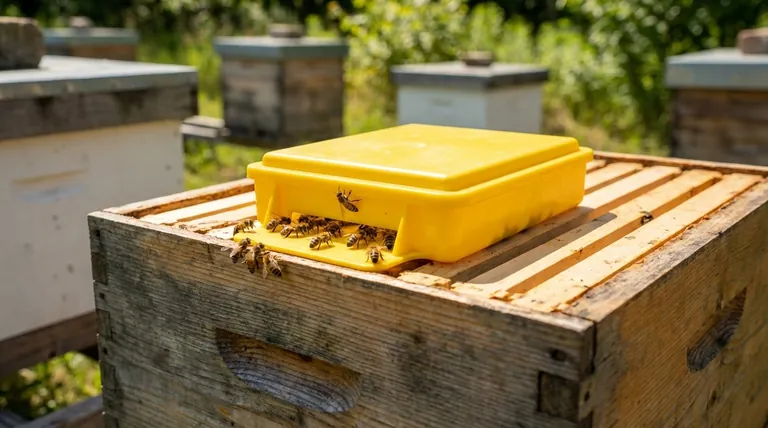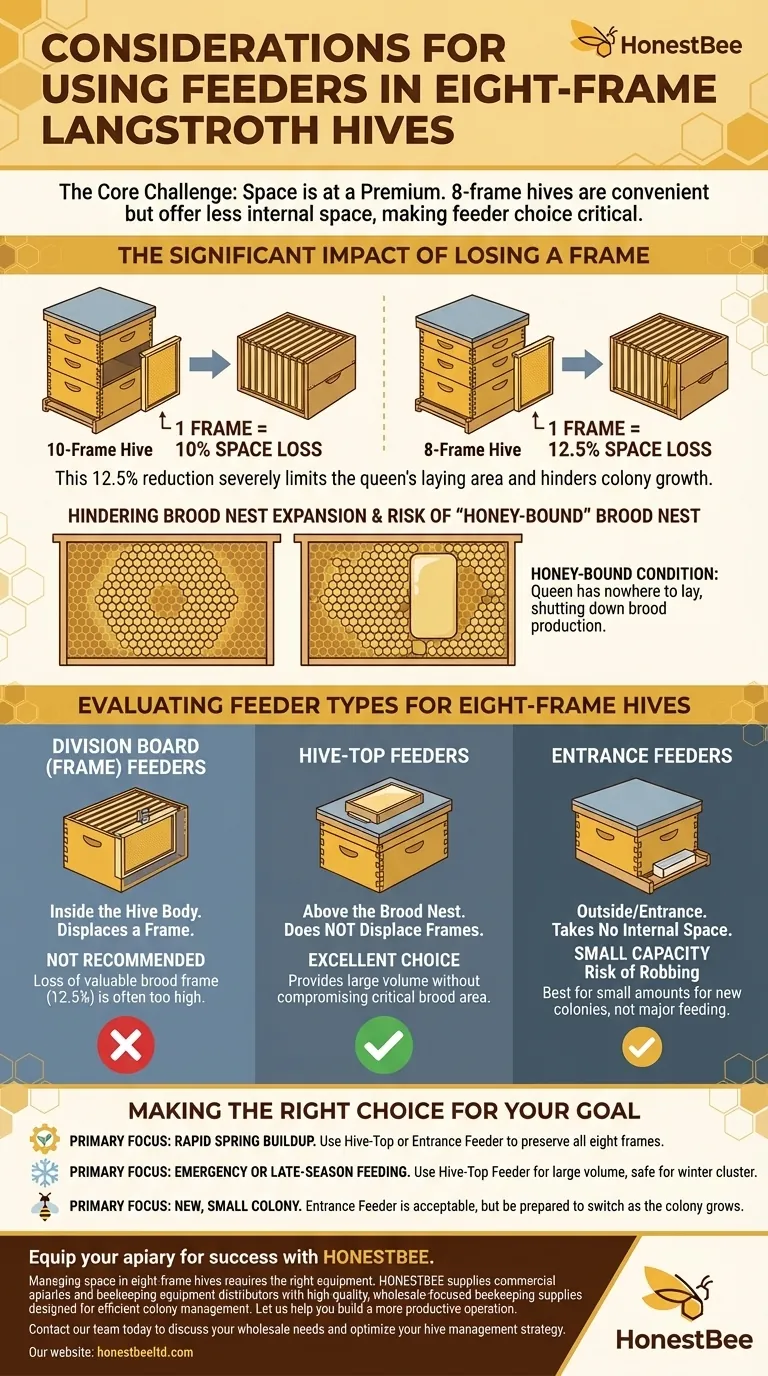When using an eight-frame hive, your primary consideration for feeding is the significant impact on brood chamber space. Feeders that sit inside the hive body, such as division board or frame feeders, require you to remove a frame. In the tighter confines of an eight-frame box, this 12.5% reduction in space can severely limit the queen's laying area and hinder colony growth, especially during spring buildup.
The central challenge with eight-frame hives is their limited volume. Your choice of feeder must prioritize preserving every frame for brood and resources, making external or top-feeding methods a far safer and more effective strategy than internal frame feeders.

The Core Challenge: Space is at a Premium
An eight-frame hive body is chosen for its lighter weight and easier handling, but this convenience comes with a critical trade-off: less internal space. Understanding this is key to successful management.
The Proportional Impact of Losing a Frame
Removing one frame from a ten-frame hive reduces the available space by 10%. In an eight-frame hive, removing one frame reduces the space by 12.5%.
This may seem like a small difference, but for a rapidly expanding colony, it represents a significant loss of real estate for raising new bees.
Hindering Brood Nest Expansion
The queen needs ample, contiguous comb to lay eggs in her preferred pattern. When you replace a frame with a feeder, you break up that space.
This can directly restrict the colony's ability to grow, a risk that is much higher in the already constrained eight-frame environment.
Evaluating Feeder Types for Eight-Frame Hives
Not all feeders are created equal, and their suitability changes dramatically when applied to an eight-frame configuration.
Division Board (Frame) Feeders
These feeders are designed to hang inside the hive body, just like a frame. While they keep the food source protected within the hive, they are the source of the primary conflict.
Using one in an eight-frame brood box is generally not recommended. The loss of a valuable brood frame is often too high a price to pay for the convenience of feeding.
Hive-Top Feeders
These feeders are placed on top of the uppermost hive body, directly under the outer cover. They add feeding space above the brood nest instead of within it.
Because they do not displace any frames, hive-top feeders are an excellent choice for eight-frame hives. They provide a large volume of syrup without compromising the critical brood area.
Entrance Feeders
These small feeders fit into the entrance of the hive. They are simple to use and refill without opening the hive, and they do not take up any internal space.
However, their capacity is very small, and they are known to sometimes incite robbing from other nearby hives. They are best for providing small amounts of syrup to a new colony, not for major feeding efforts.
Understanding the Trade-offs and Risks
Choosing the wrong feeder at the wrong time can do more harm than good, especially in a smaller hive.
The Risk of a "Honey-Bound" Brood Nest
If you feed heavily while using an internal frame feeder, you shrink the available brood area. The bees may then backfill the remaining brood cells with the syrup you are providing.
This creates a "honey-bound" condition where the queen has nowhere to lay, effectively shutting down brood production at a critical time.
Why In-Hive Feeders Are Riskiest During Buildup
During the spring and early summer, the colony's goal is rapid population growth. This is precisely when the queen needs maximum space.
Using a division board feeder during this period directly counteracts the colony's natural objective. The practice is far less risky in a ten-frame hive or in a multi-story hive during the fall, but it is a significant gamble in a single eight-frame brood box.
Making the Right Choice for Your Goal
Select your feeder based on your colony's specific needs and the time of year.
- If your primary focus is rapid spring buildup: Use a hive-top feeder or, for small amounts, an entrance feeder to preserve all eight frames for the queen.
- If your primary focus is emergency or late-season feeding: A hive-top feeder is the most efficient and safest method, as it holds a large volume and doesn't interfere with the winter cluster's space.
- If your primary focus is on a new, small colony: An entrance feeder is acceptable for initial support, but be prepared to switch to a hive-top feeder as the colony grows.
Ultimately, success with an eight-frame hive hinges on maximizing the efficiency of its limited space.
Summary Table:
| Feeder Type | Key Consideration for 8-Frame Hives | Best Use Case |
|---|---|---|
| Division Board (Frame) Feeder | Removes a brood frame (12.5% space loss); high risk of restricting colony growth. | Generally not recommended for 8-frame brood boxes. |
| Hive-Top Feeder | Adds space above the brood nest; does not displace any frames. | Excellent for all major feeding (spring buildup, fall feeding). |
| Entrance Feeder | Takes no internal space; very small capacity and can incite robbing. | Short-term feeding for very small, new colonies. |
Equip your apiary for success with HONESTBEE.
Managing space in eight-frame hives requires the right equipment. HONESTBEE supplies commercial apiaries and beekeeping equipment distributors with high-quality, wholesale-focused beekeeping supplies designed for efficient colony management.
Let us help you build a more productive operation. Contact our team today to discuss your wholesale needs and optimize your hive management strategy.
Visual Guide

Related Products
- Professional Hive Top Bee Feeder for Beekeeping
- HONESTBEE Entrance Bee Feeder Professional Hive Nutrition Solution for Beekeeping
- Boardman Entrance Bee Feeder Durable Galvanized Steel and Wood Construction for Beekeeping
- Professional Hive Front Entrance Bee Feeder
- Professional In-Hive Bee Feeder HONESTBEE Frame for Beekeeping
People Also Ask
- What types of hive boxes is the round hive top feeder compatible with? Universal Fit for 8 & 10-Frame Langstroth Hives
- Why is a top feeder essential for bees? Ensure Colony Health and Efficiency
- How is the plywood floor fitted into the hive-top feeder? Ensure Longevity with a Floating Floor Design
- What are the advantages of hive top feeders? Maximize Feeding Efficiency for Your Apiary
- How to use a top feeder in a beehive? A Guide to Effective Beehive Feeding



















